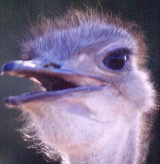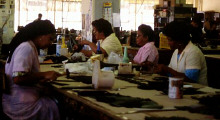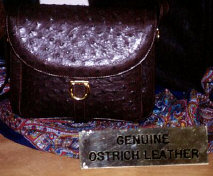When touring the Garden Route along South Africa’s southern coast I stopped at Oudtshoorn and visited the Safari Ostrich Show Farm. It was an unforgettable experience.

Don’t Eat Me
![]()
The arid countryside resembles the Australian outback. Instead of sheep there are innumerable ostriches roaming far into the distance. What a perfect farm animal for such a climate! Every part of the bird is used – leather, meat, feathers and oil, and at the nearby backpacker’s hostel, I had scrambled ostrich egg for breakfast!
The ostrich is the largest bird in the world. The male has black body feathers and fluffy white wing tips whereas the female is a uniform brown colour. This model farm has 3000 birds on 6000 hectares. We were shown the various stages of their development.
They can live to be 70 years old and mate for life. A breeding pair may produce 90 eggs in a year. About 15 eggs are kept in the nest and the rest are transferred to incubators for reliable hatching. These huge eggs take six weeks to hatch. The eggshell is 2-3 mm thick and is so strong that you can stand on the eggs without fear of breaking. Chicks take half a day to break free. A mother bird will look after as many as 80 chicks.
Being a desert bird they can go one month without water. They eat dry food, mainly maize and have two stomachs containing a kilo or more of pebbles. The ostrich will eat anything, even Coke bottles, spark plugs, and peck anything shiny – a watch, biro or ring – so be careful and don’t go too close!
Our tour group came to some bird pens and we were invited to ride an ostrich. I photographed an English woman, a grandmother, riding on the back of one. How ungainly they are! If things get rough it is easy to slide off the back. Next we watched a race of four birds ridden by some farm boys. The birds seem to enjoy this diversion.
In Cape Town I visited the leather factory of the company Reptile S.A. where they process valuable skins of ostrich, crocodile and snake to make handbags, wallets and briefcases.
There are 120 African workers, 80% are women and it takes five years training before they work on fine ostrich items. Many of the women have been employees here for 20 years.

Cape Town Factory
![]()
Ostrich leather has a distinctive quill marking caused by the feathers and is dyed in 70 colours. It costs about 1600 Rand per skin from the tannery at Oudtshoorn, or about 14 Rand per decimetre, compared to 1 Rand per decimetre for cow skin. The high cost of ostrich leather restricts its use to top quality handmade goods that are mainly exported to Japan and the USA.
The average skin is 130 “decis” and is cut to shape of a pattern. A splitting machine with rollers makes the skin thinner and more flexible – this is done along the edges and bent over. There are folding and creasing machines while gluing is done by hand. More cutting, lining and machine sewing takes place. The men do the initial cutting and also embossing, or gold stamping using gold foil.

Purchase Me
![]()
In the show room I admired men’s belts costing US$100, women’s handbags at $800 to $1200 and briefcases at $2000 to $4000; what works of art they are!
The leather is the most valuable part of the ostrich. The meat is sold in supermarkets. It is a red meat often labelled “volant steak”, or flying steak, but these birds cannot fly. It is a popular, low cholesterol meat and economical too, at least in South Africa.
Feathers are cut a few times a year. They are dyed gorgeous colours and used as fashion accessories, also in industry as feather dusters and fillings for pillows and mattresses. A wide range of ostrich products can be purchased online from the USA.
There are now many ostrich farms in Australia. Several hundred thousand birds exist here. The industry has progressed from the breeding stage to production of fine leather goods and soon Australia will be competing on the world market. Ostrich steaks are now available in gourmet food markets, however kangaroo and venison are the dominant game meats selling at a much lower price.
Questions?
If you want more information about this area you can email the author or check out our Africa Insiders page.